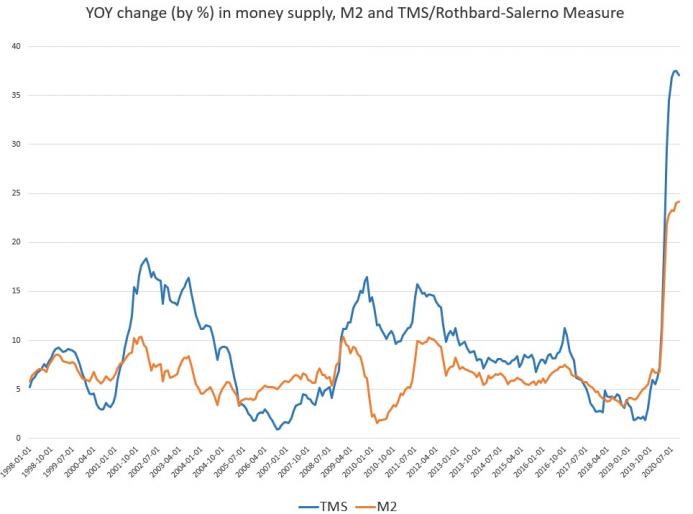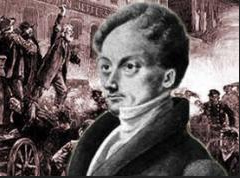[Chapter 2 of Rothbard’s newly edited and released Conceived in Liberty, vol. 5, The New Republic: 1784–1791.] It has been alleged—from that day to this—that the depression which hit the United States, especially the commercial cities, was caused by “excessive” imports by Americans beginning in 1783. But this kind of pseudo-explanation merely betrays ignorance of economics: a boom in imports reflects voluntary choices and economic improvement by consumers, and this expression of choice can scarcely be the cause of general depression. In short, an improved standard of living for the bulk of consumers reflects improvement and not depression. It is impossible for consumers to buy “too many” imports, for they must pay for them with something, and this payment is
Topics:
Murray N. Rothbard considers the following as important: 6b) Mises.org, Featured, newsletter
This could be interesting, too:
Eamonn Sheridan writes CHF traders note – Two Swiss National Bank speakers due Thursday, November 21
Charles Hugh Smith writes How Do We Fix the Collapse of Quality?
Marc Chandler writes Sterling and Gilts Pressed Lower by Firmer CPI
Michael Lebowitz writes Trump Tariffs Are Inflationary Claim The Experts
 [Chapter 2 of Rothbard’s newly edited and released Conceived in Liberty, vol. 5, The New Republic: 1784–1791.]
[Chapter 2 of Rothbard’s newly edited and released Conceived in Liberty, vol. 5, The New Republic: 1784–1791.]
It has been alleged—from that day to this—that the depression which hit the United States, especially the commercial cities, was caused by “excessive” imports by Americans beginning in 1783. But this kind of pseudo-explanation merely betrays ignorance of economics: a boom in imports reflects voluntary choices and economic improvement by consumers, and this expression of choice can scarcely be the cause of general depression. In short, an improved standard of living for the bulk of consumers reflects improvement and not depression. It is impossible for consumers to buy “too many” imports, for they must pay for them with something, and this payment is financed from exports or from previously accumulated specie. Specie, indeed, had been accumulated in the colonies by the end of the war from British and French war expenditures. In either case, the payments reflected affluence rather than destitution, and these purchases were an enormous help after the ravages of the war. A specie drain is also the result of consumer desires and obviously cannot continue indefinitely. Clearly, Americans could not merely buy from abroad and not sell; indeed, if they could have done so they would have found a utopian cornucopia in which one need only consume without having to produce or sell in exchange.
There was, however, an excess of imports, but this was not caused by the free choices of American consumers. In the first place, as we have seen above, many manufacturers were artificially expanded during the war and with the resumption of peace these businesses now had to compete with the more efficient British, who at the same time restricted American exports. In addition, there was inflationary credit expansion by the Bank of North America, headed by wealthy Philadelphia merchant and former economic czar Robert Morris, and by two new banks which sprang up in 1784 to take advantage of the large profits of this new-found occupation: the Bank of Massachusetts in Boston and the Bank of New York in New York City, the latter organized mainly by large public creditors. Each institution enjoyed a monopoly on banking in its region. Inflationary expansion of bank credit leads bank clients to believe that they have more real money than they actually possess, and this leads to an artificial expansion of imports, which must be paid for in specie. The consequent drain of specie from the expanding banks, and increased calls for payment of their notes and deposits in specie, inevitably creates difficulties for the banks and forces them into hasty contraction, which in turn leads to deflation and depression. It is this boom-bust cycle of bank credit expansion and contraction that occurred in the immediate postwar period and brought a depression in mid-1784 and 1785. This trade cycle was superimposed on and aggravated the inevitable postwar distress of over-expanded wartime manufactures by increasing imports more than would have otherwise been the case.
Excessive importation continued into the 1780s. At the end of the Revolutionary War, the contraction of the swollen mass of paper money, combined with the resumption of imports from Great Britain, cut prices by more than half in a few years.1 As we shall see below, vain attempts by seven state governments, beginning in 1785, to cure the “shortage of money” and re-inflate prices were a complete failure. Part of the reason for the state paper issues was a frantic attempt to pay the wartime public debt, state and pro rata federal, without resorting to crippling burdens of taxation. The increased paper issues merely added to the “shortage” by stimulating the export of specie and aggravated the importation of commodities from abroad.
By the end of 1783, Robert Morris had succeeded in divorcing his Bank of North America—which had begun the year before as a virtual central bank—from the federal government.2 Its growing profitability—it had paid a dividend of 14.5 percent in 1783—stimulated its own expansion as well as new bank projects. The bank increased its subscription by $500,000 in January 1784 and soon a new group, disgruntled by the loans of the Bank of North America going to favored insiders, asked for the chartering of a Bank of Pennsylvania. The Bank of North America was furious at the threat of competition at home (it worried not at all about the new banks in Boston and New York), and Pelatiah Webster, a bank stockholder, argued presumptuously in the Pennsylvania Assembly that the two banks “might act in opposition to each other and of course destroy each other,” i.e., compete. When this argument unsurprisingly failed to impress the legislators, the Bank of North America in March used the ancient device of co-optation: it expanded its new shares to $1.6 million and cut in the promoters of the new bank. Thus the Bank of North America’s expansion ended the threat of another bank in Pennsylvania. But the bank was scarcely out of trouble. Soon it was forced by liabilities accrued from its previous expansion to contract sharply during 1784 and precipitate a financial crisis.3
After the victory of the radicals in the fall 1784 elections, the victors, led by Assemblymen William Findley of Westmoreland, Robert Whitehill of Cumberland, and John Smilie of Fayette Counties, moved to repeal the charter of the Bank of North America. While the radical Constitutionalists acceded to the depression-born demand of artisan-manufacturers and passed a protective tariff, their push against the bank in the spring of 1785 precipitated a notable debate over the bank’s activities. A pamphlet war, as well as a legislative debate and mass petitions, raged over the Bank of North America. While much of the anti-bank argument was political—attacking its special privileges, its favoritism, in general its negation of the liberal ideal of equality before the law—the radicals also emerged with some sophisticated economic arguments against the bank. The Assembly committee that recommended repeal, as well as the anti-bank men in subsequent debates, stressed the crucial economic point that, as one legislator phrased it, the bank was “an engine of trade that enabled the merchants to import more goods than were necessary, or than there was money to pay for, [and that] by means of a bank the European merchants were enabled to procure and carry off money for their goods.” Then, after the temporary expansion of this fictitious credit, the bank “overtraded” and was later forced to contract and precipitate an economic crisis. In short, the radicals in the anti-bank debate of 1785, led by Findley and Smilie, adumbrated the later Ricardian theory of banking and international trade which was also in essence a monetary theory of the trade cycle. The following year, the eminent Reverend John Witherspoon, in his Essay on Money (1786), though favoring the bank, explained in greater detail how inflation of bank paper raises prices and drives specie out of the country. Indeed, in the course of the controversy an anonymous pamphleteer, “Nestor,” first proposed in America the “currency principle” of 100 percent specie backing for bank liabilities and argued that a bank “should not emit a single note beyond the sum of specie in its possession.”
In accordance with his general theory of the history of American banking struggles, the historian Bray Hammond persists in labeling the radical hard-money opposition to the bank “agrarian,” even though he inconsistently admits that wealthy Philadelphia capitalists like George Emlen also stood for hard money and against the bank. This view, furthermore, is hard to square with the fact that the Philadelphia delegates (at this point radicals) voted overwhelmingly for repeal of the bank charter.4
To defend its existence, the Bank of North America brought out heavy guns indeed, all its supporters being either stockholders, in pay of, or in debt to, the bank. Leading the defenses was the noted James Wilson, the bank’s counselor and heavily in the bank’s debt. Wilson not only advanced the specious legal argument that the bank’s charter, though granted as a privilege by the state, was now somehow its “property right”; he also insisted that the cause of the depression was only excessive importation per se. Other prominent defenders were Robert Morris, Gouverneur Morris, and Pelatiah Webster, who opined that “a good bank may increase the circulating medium of a State to double or treble the quantity of real cash, without increasing the real money, or incurring the least danger of a depreciation.”
The Pennsylvania Assembly overwhelmingly repealed the charter of the Bank of North America in September 1785, but the debate continued to rage. Finally, the conservatives’ political victory in the 1786 elections, in which they carried Philadelphia and eastern Pennsylvania, led to the re-charter of the bank in the following year, though with considerably restricted powers.
The most inglorious role in the continuing debate was played by Thomas Paine, author of the fiery libertarian pamphlet Common Sense (1776), who was reportedly hired by the bank to lend his formidable pen to its cause. In a 1786 pamphlet, Paine not only defended bank inflation and advanced the flimsy “property right” argument, he had the presumption to urge that the state privilege the bank by making it a kind of central bank to the commonwealth, with the state borrowing from the bank instead of issuing state paper to meet its expenses. Understandably denounced by his old radical comrades as a mercenary renegade, Paine not only mendaciously denied any vested interest in defending the bank, but he also lashed out at the opposition as an unholy alliance of irresponsible frontiersmen and urban capitalists and usurers. So far had Paine advanced down the right-wing road that he now advocated a return to a bicameral legislature.
- 1. [Editor’s footnote] For more on Revolutionary War finance, see Murray Rothbard, Conceived in Liberty, vol. 4: The Revolutionary War, 1775–1784 (Auburn, AL: Mises Institute, 1999), pp. 1487–97, 1508–13; pp. 373–83, 394–99. The original Conceived in Liberty volumes were published in individual editions. Page numbers to the earlier individual editions will follow page numbers to the 2011 all-in-one edition.
- 2. [Editor’s footnote] For more on the Bank of North America, see ibid., pp. 1506–07, 1523–24; pp. 388–93, 409–10.
- 3. The Bank of Massachusetts, having expanded from its inception in 1784, was also forced to contract as losses hit its mercantile customers in the spring of 1785; this contraction aggravated the depression during that year.
- 4. Bray Hammond, in his eagerness to denigrate the radicals, discusses only their political arguments and completely omits their economic reasoning. Bray Hammond, Banks and Politics in America (Princeton, NJ: Princeton University Press, 1957), pp. 53–62. In addition, see ibid., pp. 87–88. Contrast Hammond’s analysis with the thorough and judicious treatment in Joseph Dorfman, The Economic Mind in American Civilization, 1606–1865, vol. 1 (New York: The Viking Press, 1946), pp. 260–68. See also Harry E. Miller, Banking Theories in the United States before 1860 (Cambridge, MA: Harvard University Press, 1927), pp. 23, 30, 49–51, 139; Robert L. Brunhouse, The Counter Revolution in Pennsylvania, 1776–1790 (Harrisburg, PA: Pennsylvania Historical Commission, 1942), pp. 172–75. [Editor’s remarks] Nettels, The Emergence of a National Economy, pp. 61–62, 77–81.
Tags: Featured,newsletter







